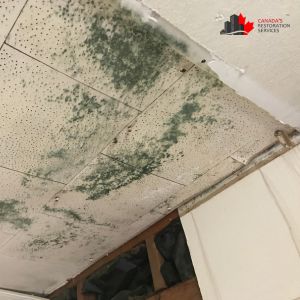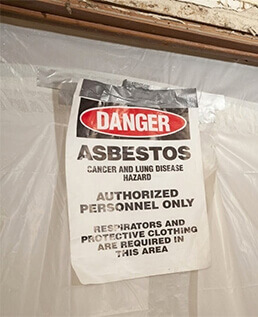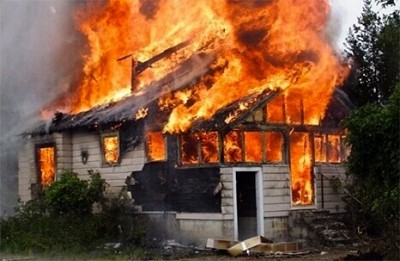Signs There is Mold Growing On Your Bathroom Ceiling
Posted in Mold Removal, on April 16, 2025
Mold spores are attracted to spaces that have low ventilation and high levels of moisture, which makes the bathroom a common space in which building owners can find infestations. The ceiling is especially vulnerable as steam from showers rises and condenses on surfaces above, encouraging mold growth if not managed correctly with professional mold removal in Toronto. Even minor water leaks can spiral into full-blown mold infestations, affecting both your health, loved ones, and the structural integrity of important building materials. Whether you're a homeowner or property manager, spotting early signs of mold is crucial for maintaining a healthy environment and avoiding costly repairs. If you identify indicators of mold in your bathroom or ceilings, call Canada's Restoration Services for mold removal and ceiling water damage repair. Our IICRC-certified experts provide comprehensive, reliable, and efficient remediation and repair services for mold and water damage in Toronto.
For more insight into signs of mold growing on your bathroom ceiling, read on.
Persistent Musty Odours
 One of the earliest and often overlooked indicators of mold growth is a musty smell that lingers even after cleaning. Mold has a distinct, earthy odour caused by microbial volatile organic compounds (MVOCs) or mycotoxins released during its life cycle. As it spreads, those toxins are released into the air, leaving behind a pungent odour that worsens over time.
One of the earliest and often overlooked indicators of mold growth is a musty smell that lingers even after cleaning. Mold has a distinct, earthy odour caused by microbial volatile organic compounds (MVOCs) or mycotoxins released during its life cycle. As it spreads, those toxins are released into the air, leaving behind a pungent odour that worsens over time.
If your bathroom smells stale or dank shortly after using it, mold may be present above the surface. Sometimes these odors originate from the insulation or drywall behind the ceiling, indicating a deeper issue that may require professional mold removal in Toronto to assess and remediate.
Discoloured or Stained Ceiling Patches
Changes in colour and other visible signs are the easiest ways to identify mold. Brown, yellow, or black patches on your ceiling are visual red flags. These discolourations often appear as water stains at first, which occur after water damage in Toronto, and then turn darker as mold takes hold.
Textured ceilings can mask early signs of mold growth, so a flashlight can help inspect any irregular areas. If you spot green or black specks, or if the paint seems cracked or bubbling, it may be time for an inspection followed by expert ceiling water damage repair services.
Peeling or Bubbling Paint
As the leading cause of mold infestation, water damage is the first sign of mold. In just 48 hours, property owners can see that the need for ceiling water damage repair has turned into a need for mold removal in Toronto. When moisture becomes trapped between paint and drywall, it causes the surface to peel, crack, or bubble. This not only looks unsightly but also creates the perfect hiding place for mold to grow.
In many cases, this damage is caused by water damage in Toronto properties due to persistent humidity, faulty exhaust systems, or unnoticed leaks. Fast mold inspections and comprehensive water damage cleanup with Canada's Restoration Services can help catch the problem before mold has a chance to spread.
Physiological Health Symptoms When Using the Bathroom
An increase or onset of sneezing, coughing, or eye and skin irritation while you're in the bathroom could be allergic reactions to airborne mold spores. Though not a visual sign, health symptoms often go hand-in-hand with hidden mold infestations. If symptoms seem to improve once you leave the room, it's worth scheduling a mold removal in Toronto consultation to rule out contamination, especially if you notice it alongside visible signs of mold.
What Causes Mold in Bathroom Ceilings?
There are several culprits behind bathroom ceiling mold, including:
- Leaking pipes or fixtures
- Improper waterproofing
- Standing water or condensation
- Poor quality building materials
- Unsealed grout or caulking
- Attic roof leaks
- Poor, insufficient, or blocked ventilation
If your home has recently experienced water damage in Toronto due to storms or plumbing failures, it's vital to monitor all high-moisture areas like your ceiling.
Why Ventilation Matters
Poor ventilation is one of the leading causes of mold growth. Without proper airflow, moisture lingers, encouraging mold to thrive. It's a good idea to run your bathroom exhaust fans during and after showers to remove humid air.
However, for this to be effective, you should check that your exhaust fan vents externally and not just into the attic to ensure you're not increasing the chances of mold in your attic. Installing a humidity-sensing fan or upgrading your existing model can significantly reduce mold risk.
Is Your Attic Contributing to Bathroom Mold?
Attics are typically hot spots for mold, and problems that are happening in the attic can literally trickle down into the bathroom or next floor of your home. If your attic insulation is no longer effective or it is not sufficiently ventilated, condensation can form and seep into the bathroom ceiling. This creates the perfect environment for mold to grow.
Attic leaks, especially in older homes or those affected by water damage in Toronto, can introduce hidden moisture. Look for sagging insulation, ice damming, or signs of rot. A home inspection may reveal the need for integrated repairs from the attic down to the ceiling.
Protect Your Home with Mold Removal and Water Damage Repair in Toronto
At Canada's Restoration Services, we offer a full suite of restoration services from mold removal in Toronto to flood cleanup and ceiling water damage repair. Our experts are IICRC-certified and take a responsible, effective, and safe approach to water damage emergencies and mold removal, from inspection to restoration. To learn more about how our experts can help you get mold out of your home, book an inspection.







